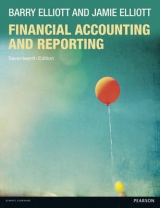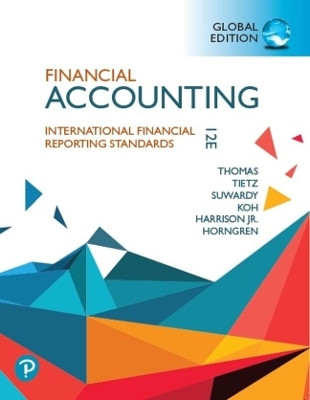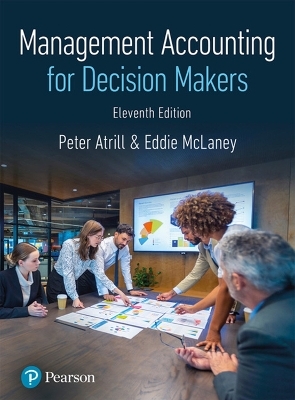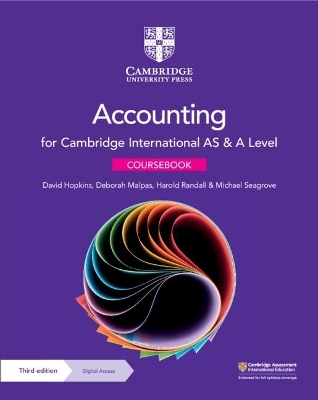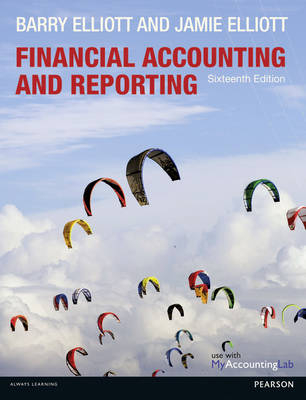
Financial Accounting and Reporting with MyAccountingLab access card
Pearson Education Limited
978-0-273-77826-4 (ISBN)
- Titel erscheint in neuer Auflage
- Artikel merken
This market-leading text offers a comprehensive overview of financial accounting and reporting. You will find worked examples and useful illustrations throughout the text to support your learning. With both theoretical and practical coverage, the authors provide essential knowledge that you need to advance in your studies and career.
MyLab and Mastering from Pearson improve results for students and educators. Used by over ten million students, they effectively engage learners at every stage.
With a proven 45% increase in pass rates, MyAccountingLab has helped students make strides in learning for over 10 years. MyAccountingLab has immersive content and tools that are so engaging that one student called it, "A perfect combination between pictures, videos and text. It's genius!" With MyAccountingLab, students gain knowledge that they will use throughout their lives, and universities gain a partner deeply committed to helping students and educators achieve their goals.
For students
Personalised study plan: MyAccountingLab gives you the opportunity to test yourself on key concepts and skills and generates a study plan based on topics you have not yet mastered. The study plan links to interactive exercises with guidance, to give you help when you need it most.
Pearson eText gives you access to an ebook that can be used on the go, and allows you to highlight, search and take notes as you read online. Access to the ebook depends on the package you have bought.
For educators
Online assignments, tests and quizzes can be easily created and assigned to students.
Gradebook: Assignments are automatically graded and visible at a glance.
Register now to benefit from these resources.
For educator access, contact your Pearson account manager. To find out who your account manager is, visit www.pearsoned.co.uk/replocator
For more instructor resources available with this title, visit www.pearsoned.co.uk
Part 1
PREPARATION OF FINANCIAL STATEMENTS
1 Accounting and reporting on a cash flow basis
2 Accounting and reporting on an accrual accounting basis
3 Preparation of Financial Statements of comprehensive income, Changes in equity and Financial Position
4 Annual Report: additional financial statements
5 Statements of cash flows
Part 2
INCOME AND ASSET VALUE MEASUREMENT SYSTEMS
6 Income and asset value measurement: an economist's approach
7 Accounting for price-level changes
8 Revenue recognition
Part 3
REGULATORY FRAMEWORK - AN ATTEMPT TO ACHIEVE UNIFORMITY
9 Financial reporting - evolution of global standards
10 Concepts - evolution of a international conceptual framework
11 Ethical behaviour and implications for accountants
Part 4
STATEMENT OF FINANCIAL POSITION - EQUITY, LIABILITY AND ASSET MEASUREMENT AND DISCLOSURE
12 Share capital, distributable profits and reduction of capital
13 Liabilities
14 Financial instruments
15 Employee benefits
16 Taxation in company accounts
17 Property, plant and equipment (PPE)
18 Leasing
19 R goodwill; intangible assets and brands
20 Inventories
21 Construction contracts
Part 5
CONSOLIDATED ACCOUNTS
22 Accounting for groups at the date of acquisition
23 Preparation of consolidated statements of financial position after the date of acquisition
24 Preparation of consolidated statements of comprehensive income, changes in equity and cash flows
25 Accounting for associates and joint ventures
26 Accounting for the effects of changes in foreign exchange rates under IAS 21
Part 6
INTERPRETATION
27 Earnings per share
28 Analysing statements for management purposes
29 Analytical analysis - selective use of ratios
30 An introduction to financial reporting on the Internet
Part 7
ACCOUNTABILITY
31 Corporate governance
32 Sustainability - environmental and social reporting
Index
Full contents
Preface and acknowledgements
Guided tour of MyAccountingLab
Part 1
PREPARATION OF FINANCIAL STATEMENTS
1 Accounting and reporting on a cash flow basis
1.1 Introduction
1.2 Shareholders
1.3 What skills does an accountant require in respect of external reports?
1.4 Managers
1.5 What skills does an accountant require in respect of internal reports?
1.6 Procedural steps when reporting to internal users
1.7 Agency costs
1.8 Illustration of periodic financial statements prepared under the cash flow concept to disclose realised operating cash flows
1.9 Illustration of preparation of statement of financial position
1.10 Treatment of non-current assets in the cash flow model
1.11 What are the characteristics of these data that make them reliable?
1.12 Reports to external users
Summary
Review questions
Exercises
References
2 Accounting and reporting on an accrual accounting basis
2.1 Introduction
2.2 Historical cost convention
2.3 Accrual basis of accounting
2.4 Mechanics of accrual accounting - adjusting cash receipts and payments
2.5 Subjective judgements required in accrual accounting - adjusting cash payments in accordance with the matching principle
2.6 Mechanics of accrual accounting - the statement of financial position
2.7 Reformatting the statement of financial position
2.8 Accounting for the sacrifice of non-current assets
2.9 Reconciliation of cash flow and accrual accounting data
Summary
Review questions
Exercises
References
3 Preparation of Financial Statements of comprehensive income, Changes in equity and Financial Position
3.1 Introduction
3.2 Preparing an internal statement of income from a trial balance
3.3 Reorganise the income and expenses into one of the formats required for publication
3.4 Format 1: Classification of operating expenses and other income by function
3.5 Format 2: classification of operating expenses according to their nature
3.6 Other comprehensive income
3.7 How non-recurring or exceptional items can affect operating income
3.8 How decision useful is the Statement of comprehensive income?
3.9 Statement of Changes in Equity
3.10 The statement of financial position
3.11 The explanatory notes that are part of the financial statements
3.12 Has prescribing the formats meant that identical transactions are reported identically?
3.13 Fair presentation
3.14 What does an investor need in addition to the primary financial statements to make decisions?
Summary
Review questions
Exercises
References
4 Annual Report: additional financial statements
4.1 Introduction
4.2 IAS 10 Events after the reporting period 1
4.3 Retrospective changes to financial statements
4.4 What do segment reports provide?
4.5 IRFS 8 - Operating Segments
4.6 Benefits and continuing concerns following the issue of IFRS 8
4.7 Discontinued operations - IFRS 5 Non-current assets held for sale and discontinued operations
4.8 Held for sale - IFRS 5 Non-current assets held for sale and discontinued operations
4.9 Related party disclosures -IAS 24 Related Party Disclosures
Summary
Review questions
Exercises
References
5 Statements of cash flows
5.1 Introduction
5.2 Development of statements of cash flows
5.3 Applying IAS 7 (revised) Statements of Cash Flows
5.4 Step approach to preparation of a statement of cash flows - indirect method
5.5 Additional notes required by IAS 7
5.6 Analysing statements of cash flows
5.7 Approach to an exam question
5.8 Critique of cash flow accounting
Summary
Review questions
Exercises
References
Part 2
INCOME AND ASSET VALUE MEASUREMENT SYSTEMS
6 Income and asset value measurement: an economist's approach
6.1 Introduction
6.2 Role and objective of income measurement
6.3 Accountant's view of income, capital and value
6.4 Critical comment on the accountant's measure
6.5 Economist's view of income, capital and value
6.6 Critical comment on the economist's measure
6.7 Income, capital and changing price levels
Summary
Review questions
Exercises
References
Bibliography
7 Accounting for price-level changes
7.1 Introduction
7.2 Review of the problems of historical cost accounting (HCA)
7.3 Inflation accounting
7.4 The concepts in principle
7.5 The four models illustrated for a company with cash purchases and sales
7.6 Critique of each model
7.7 Operating capital maintenance - a comprehensive example
7.8 Critique of CCA statements
7.9 The ASB approach
7.10 The IASC/IASB approach
7.11 Future developments
Summary
Review questions
Exercises
References
Bibliography
8 Revenue recognition
8.1 Introduction
8.2 The issues
8.3 The challenge
8.4 Proposed IFRS Revenue from Contracts with Customers
8.5 Harmonisation
Summary
Review questions
Exercises
References
Part 3
REGULATORY FRAMEWORK - AN ATTEMPT TO ACHIEVE UNIFORMITY
9 Financial reporting - evolution of global standards
9.1 Introduction
9.2 Why do we need financial reporting standards?
9.3 Why do we need standards to be mandatory?
9.4 Arguments in support of standards
9.5 Arguments against standards
9.6 Standard setting and enforcement in the UK under the Financial Reporting Council (FRC)
9.7 The Accounting Standards Board (ASB)
9.8 Standard setting an enforcement in The European Union
9.9 Standard setting and enforcement in the US
9.10 Advantages and disadvantages of global standards for publicly accountable entities
9.11 How do reporting requirements differ for non-publicly accountable entities?
9.12 IFRS for SMEs
9.13 Why have there been differences in financial reporting?
9.14 Move towards a conceptual framework
Summary
Review questions
Exercises
References
10 Concepts - evolution of a international conceptual framework
10.1 Introduction
10.2 Different countries meant different financial statements
10.3 Historical overview of the evolution of financial accounting theory
10.4 IASC Framework for the Presentation and Preparation of Financial Statements
10.5 Conceptual Framework for Financial Reports 2010
10.6 Phase A of the Conceptual Framework
10.7 ASB Statement of Principles 1999
Summary
Review questions
Exercises
References
11 Ethical behaviour and implications for accountants
11.1 Introduction
11.2 The meaning of ethical behaviour
11.3 The accounting standard setting process and ethics
11.4 The IFAC Code of Ethics for Professional Accountants
11.5 Implications of ethical values for the principles versus rules-based approaches to accounting standards
11.6 Ethics in the accountants' work environment research report
11.7 Implications of unethical behaviour for stakeholders using the financial reports
11.8 The increasing role of whistle blowing
11.9 The role of financial reporting authorities
11.10 Why should students learn ethics?
Summary
Review questions
Exercises
References
Part 4
STATEMENT OF FINANCIAL POSITION - EQUITY,
LIABILITY AND ASSET MEASUREMENT AND DISCLOSURE 289
12 Share capital, distributable profits and reduction of capital
12.1 Introduction
12.2 Common themes
12.3 Total owners' equity: an overview
12.4 Total shareholders' funds: more detailed explanation
12.5 Accounting entries on issue of shares
12.6 Creditor protection: capital maintenance concept
12.7 Creditor protection: why capital maintenance rules are necessary
12.8 Creditor protection: how to quantify the amounts available to meet creditors' claim
12.9 Issued share capital: minimum share capital
12.10 Distributable profits: general considerations
12.11 Distributable profits: how to arrive at the amount using relevant accounts
12.12 When may capital be reduced?
12.13 Writing off part of capital which has already been lost and is not represented by assets
12.14 Repayment of part of paid-in capital to shareholders or cancellation of unpaid share capital
12.15 Purchase of own shares
Summary
Review questions
Exercises
References
13 Liabilities
13.1 Introduction
13.2 Provisions - a decision tree approach to their impact on the statement of financial position
13.3 Provisions
13.4 What are the general principles that IAS 37 applies to the recognition of a provision?
13.5 Management approach to measuring the amount of a provision
13.6 Application of criteria illustrated
13.7 Provisions for specific purposes
13.8 Contingent liabilities
13.9 Contingent assets
13.10 ED IAS 37 Non-financial Liabilities
13.11 ED/2010/1 Measurement of Liabilities in IAS 37
Summary
Review questions
Exercises
References
14 Financial instruments
14.1 Introduction
14.2 Financial instruments - the IASB's problem child
14.3 IAS 32 Financial Instruments: Disclosure and Presentation
14.4 IAS 39 Financial Instruments: Recognition and Measurement
14.5 IFRS 7 Financial Statement Disclosures
14.6 Financial instruments developments
Summary
Review questions
Exercises
References
15 Employee benefits
15.1 Introduction
15.2 Greater employee interest in pensions
15.3 Financial reporting implications
15.4 Types of scheme
15.5 Defined contribution pension schemes
15.6 Defined benefit pension schemes
15.7 IAS 19 (revised) Employee Benefits
15.8 The liability for pension and other post-retirement costs
15.9 The statement of comprehensive income
15.10 Comprehensive illustration
15.11 Plan curtailments and settlements
15.12 Multi-employer plans
15.13 Disclosures
15.14 Other long-service benefits
15.15 Short-term benefits
15.16 Termination benefits
15.17 Exposure draft of amendments to IAS 19
15.18 IFRS 2 Share-Based Payment
15.19 Scope of IFRS 2
15.20 Recognition and measurement
15.21 Equity-settled share-based payments
15.22 Cash-settled share-based payments
15.23 Transactions which may be settled in cash or shares
15.24 IAS 26 Accounting and Reporting by Retirement Benefit Plans
Summary
Review questions
Exercises
References
16 Taxation in company accounts
16.1 Introduction
16.2 Corporation tax
16.3 Corporation tax systems - the theoretical background
16.4 Corporation tax systems - avoidance and evasion
16.5 Corporation tax - the system from 6 April 1999
16.6 IFRS and taxation
16.7 IAS 12 - accounting for current taxation
16.8 Deferred tax
16.9 FRS 19 (the UK standard on deferred taxation)
16.10 A critique of deferred taxation
16.11 Examples of companies following IAS 12
16.12 Value added tax (VAT)
Summary
Review questions
Exercises
References
17 Property, plant and equipment (PPE)
17.1 Introduction
17.2 PPE - concepts and the relevant IASs and IFRSs
17.3 What is PPE? (IAS 16)
17.4 How is the cost of PPE determined?
17.5 What is depreciation?
17.6 What are the constituents in the depreciation formula?
17.7 Calculation of depreciation
17.8 Measurement subsequent to initial recognition
17.9 IAS 36 Impairment of Assets
17.10 IFRS 5 Non-Current Assets Held for Sale and Discontinued Operations
17.11 Disclosure requirements
17.12 Government grants towards the cost of PPE (IAS 20)
17.13 Investment properties
17.14 Effect of accounting policy for PPE on the interpretation of the financial statements
Summary
Review questions
Exercises
References
18 Leasing
18.1 Introduction
18.2 Background to leasing
18.3 Why was the IAS 17 approach so controversial?
18.4 IAS 17 - classification of a lease
18.5 Accounting requirements for operating leases
18.6 Accounting requirements for finance leases
18.7 Example allocating the finance charge using the sum of the digits method
18.8 Accounting for the lease of land and buildings
18.9 Leasing - a form of off balance sheet financing
18.10 Accounting for leases - a new approach
18.11 Classification of leases
18.12 The significance of options to extend the lease
18.13 Implications of the revenue recognition standard
18.11 Accounting for leases by lessors
Summary
Review questions
Exercises
References
19 R goodwill; intangible assets and brands
19.1 Introduction
19.2 Intangible assets defined
19.3 Accounting treatment for research and development
19.4 Why is research expenditure not capitalised?
19.5 Capitalising development costs
19.6 Disclosure of R&D
19.7 IFRS for SMEs
19.8 Internally generated and purchased goodwill
19.9 The accounting treatment of goodwill
19.10 Critical comment on the various methods that have been used to account for goodwill
19.11 Negative goodwill
19.12 Brands
19.13 Accounting for acquired brands
19.14 Emissions trading
19.15 Intellectual capital disclosures (ICDs) in the annual report
19.16 Review of implementation of IFRS 3
Summary
Review questions
Exercises
References
20 Inventories
20.1 Introduction
20.2 Inventory defined
20.3 The controversy
20.4 IAS 2 Inventories
20.5 Inventory valuation
20.6 Work-in-progress
20.7 Inventory control
20.8 Creative accounting
20.9 Audit of the year-end physical inventory count
20.10 Published accounts
20.11 Agricultural activity
Summary
Review questions
Exercises
References
21 Construction contracts
21.1 Introduction
21.2 The need to replace IAS 11 Construction Contracts
21.3 Identification of contract revenue
21.4 Identification of contract costs
21.5 Proposed new accounting rules
21.6 Approach when a contract can be separated into components
21.7 Accounting for a contract
21.8 Illustrated - profitable contract using step approach
21.9 Illustrated - loss-making contract using step approach
21.10 Public-private partnerships (PPPs)
Summary
Review questions
Exercises
References
Part 5
CONSOLIDATED ACCOUNTS
22 Accounting for groups at the date of acquisition
22.1 Introduction
22.2 Preparing consolidated accounts for a wholly owned subsidiary
22.3 Preparing consolidated accounts when there is a partly owned subsidiary
22.4 The treatment of differences between a subsidiary's fair value and book value
22.5 Parent issues shares to acquire shares in a subsidiary
22.6 IFRS 10 provisions
22.7 IFRS 3 Business Combinations Treatment of goodwill
22.8 When may a parent company not be required to prepare consolidated accounts?
22.9 When may a parent company exclude or not exclude a subsidiary from a consolidation?
22.10 IFRS 13 Fair Value Measurement
22.11 What advantages are there for stakeholders from requiring groups to prepare consolidated accounts?
Summary
Review questions
Exercises
References
23 Preparation of consolidated statements of financial position after the date of acquisition
23.1 Introduction
23.2 Uniform accounting policies and reporting dates
23.3 Pre- and post-acquisition profits/losses
23.4 The Bend Group - assuming there have been no inter-group transactions
23.5 Inter-company transactions
23.6 The Bend Group - assuming there have been inter-group transactions
23.7 How is the investment in subsidiaries reported in the parent's own statement of financial position?
Summary
Review questions
Exercises
References
24 Preparation of consolidated statements of comprehensive income, changes in equity and cash flows
24.1 Introduction
24.2 Preparation of a consolidated statement of comprehensive income - the Ante Group 620
24.3 The statement of changes in equity (SOCE)
24.4 Other consolidation adjustments
24.5 A subsidiary acquired part of the way through the year
24.6 Published format statement of comprehensive income
24.7 Consolidated statements of cash flows
Summary
Review questions
Exercises
References
25 Accounting for associates and joint ventures
25.1 Introduction
25.2 Definitions of associates and of significant influence
25.3 The treatment of associated companies in consolidated accounts
25.4 The Brill Group - the equity method illustrated
25.5 The treatment of provisions for unrealised profits
25.6 The acquisition of an associate part-way through the year
25.7 Joint arrangements
Summary
Review questions
Exercises
References
26 Accounting for the effects of changes in foreign exchange rates under IAS 21
26.1 Introduction
26.2 The rules on the recording of foreign currency transactions in a company's own books
26.3 Boil plc - a more detailed illustration
26.4 IAS 21 concept of functional and presentational currencies
26.5 Translating the functional currency into the presentation currency
26.6 Preparation of consolidated accounts
26.7 How to reduce risk of translation differences
26.8 IAS 29 Financial Reporting in Hyperinflationary Economies
Summary
Review questions
Exercises
References
Part 6
INTERPRETATION
27 Earnings per share
27.1 Introduction
27.2 Why is the earnings per share figure important?
27.3 How is the EPS figure calculated?
27.4 The use to shareholders of the EPS
27.5 Illustration of the basic EPS calculation
27.6 Adjusting the number of shares used in the basic EPS calculation
27.7 Rights issues
27.8 Adjusting the earnings and number of shares used in the diluted EPS calculation
27.9 Procedure where there are several potential dilutions
27.10 Exercise of conversion rights during financial year
27.11 Disclosure requirements of IAS 33
27.12 The Improvement Project
27.13 Convergence project
Summary
Review questions
Exercises
References
28 Analysing financial statements for management purposes
28.1 Introduction
28.2 Overview of techniques for the analysis of financial data
28.3 Ratio analysis -a case study
28.4 Introductory review
28.5 Financial statement analysis part 1 - financial performance
28.6 Financial statement analysis part 2 - liquidity
28.7 Financial statement analysis part 3 - financing
28.8 Peer comparison
28.9 Report based on the analysis
28.10 Caution when using ratios for prediction
Summary
Review questions
Exercises
Chapter 29 to follow
Summary
Review questions
Exercises
References
30 An introduction to financial reporting on the Internet
30.1 Introduction
30.2 The reason for the development of a business reporting language
30.3 Reports and the flow of information pre-XBRL
30.4 What are HTML, XML and XBRL?
30.5 Reports and the flow of information post-XBRL
30.6 XBRL and the IASB
30.7 Why should companies adopt XBRL?
30.8 What is needed to use XBRL for outputting information?
30.9 What is needed when receiving XBRL output information?
30.10 Progress of XBRL development for internal accounting
30.11 Further study
Summary
Review questions
Exercises
References
Bibliography
Part 7
ACCOUNTABILITY
31 Corporate Governance
31.1 Introduction
31.2 A systems perspective
31.3 Different jurisdictions have different governance priorities
31.4 Pressures on good governance behaviour vary over time
31.5 Types of past unethical behaviour
31.6 The effect on capital markets of good corporate governance
31.7 Risk management
31.8 The role of internal control and internal audit in corporate governance
31.9 External audits in corporate governance
31.10 Executive remuneration in the UK
31.11 Corporate governance, legislation and codes
31.12 Corporate governance - the UK experience
Summary
Review questions
Exercises
References
32 Sustainability - environmental and social reporting
32.1 Introduction
32.2 An overview - stakeholders growing interest in corporate social responsibility (CSR)
32.3 An overview - Business growing interest in corporate social responsibility
32.4 Companies voluntary adoption of Guidelines and certification
32.5 The accountant's role in a capitalist industrial society
32.6 The nature of the accountant's involvement
32.7 Summary on environmental reporting
32.8 Concept of social accounting
32.9 Background to social accounting
32.10 Corporate social responsibility reporting
32.11 Need for comparative data
32.12 Investors
32.13 The accountant's changing role
Summary
Review questions
Exercises
References
Bibliography
Index
| Verlagsort | Harlow |
|---|---|
| Sprache | englisch |
| Maße | 190 x 246 mm |
| Gewicht | 1510 g |
| Themenwelt | Wirtschaft ► Betriebswirtschaft / Management ► Rechnungswesen / Bilanzen |
| ISBN-10 | 0-273-77826-9 / 0273778269 |
| ISBN-13 | 978-0-273-77826-4 / 9780273778264 |
| Zustand | Neuware |
| Informationen gemäß Produktsicherheitsverordnung (GPSR) | |
| Haben Sie eine Frage zum Produkt? |
aus dem Bereich
